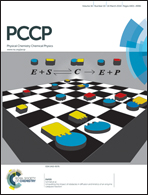Dye-sensitized solar cells using ethynyl-linked porphyrin trimers†
Abstract
Toward the extension of the light-harvesting region of sensitizers in dye-sensitized solar cells (DSSCs), two ethynyl-linked porphyrin trimers were synthesized and investigated. The zinc–freebase–zinc trimer (Zn–FbA–Zn) showed an absorption maximum at a longer wavelength than the all-zinc trimer (Zn–ZnA–Zn), although the energy level of Zn–FbA–Zn was lower than that of Zn–ZnA–Zn. The DSSCs using these trimers showed spectral sensitivities up to 900 nm. Reflecting the energy levels of these trimers, the DSSC using Zn–ZnA–Zn showed better performance than that using Zn–FbA–Zn. After the optimization of cell fabrication conditions, the photoelectric conversion efficiency η of the DSSC using Zn–ZnA–Zn reached 3.17%. The larger TiO2 nanoparticles (ca. 37 nm) than the conventional cases (ca. 13 nm) were found to be preferable in this case, due to high molar extinction coefficients of the porphyrin trimers.


 Please wait while we load your content...
Please wait while we load your content...